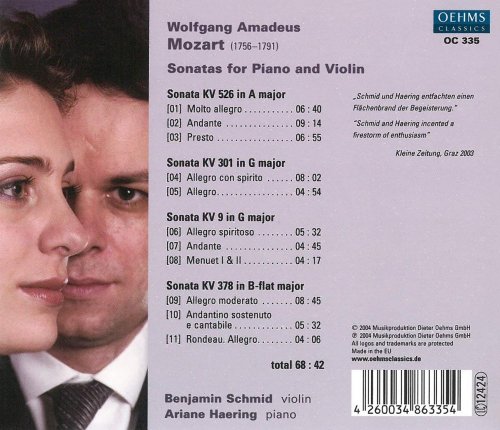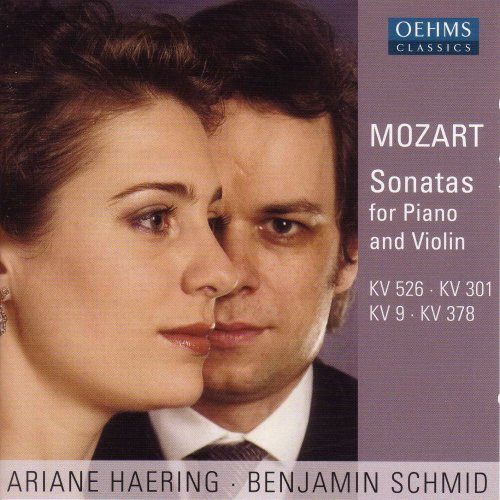
Ariane Haering & Benjamin Schmid - Mozart: Violin Sonatas Nos. 4, 18, 26 and 35 (2008)
BAND/ARTIST: Ariane Haering, Benjamin Schmid
- Title: Mozart: Violin Sonatas Nos. 4, 18, 26 and 35
- Year Of Release: 2008
- Label: Oehms Classics
- Genre: Classical
- Quality: flac lossless (tracks)
- Total Time: 01:08:47
- Total Size: 255 mb
- WebSite: Album Preview
Tracklist
01. Sonata for Keyboard and Violin No. 35 in A Major, K. 526: I. Molto allegro
02. Sonata for Keyboard and Violin No. 35 in A Major, K. 526: II. Andante
03. Sonata for Keyboard and Violin No. 35 in A Major, K. 526: III. Presto
04. Violin Sonata No. 18 in G Major, K. 301: I. Allegro con spirito
05. Violin Sonata No. 18 in G Major, K. 301: II. Allegro
06. Violin Sonata No. 4 in G Major, K. 9: I. Allegro spiritoso
07. Violin Sonata No. 4 in G Major, K. 9: II. Andante
08. Violin Sonata No. 4 in G Major, K. 9: III. Menuet I and II
09. Violin Sonata No. 26 in B-Flat Major, K. 378: I. Allegro moderato
10. Violin Sonata No. 26 in B-Flat Major, K. 378: II. Andantino sostenuto e cantabile
11. Violin Sonata No. 26 in B-Flat Major, K. 378: III. Rondo: Allegro

Mozart's sonatas for piano and violin present two issues of balance: the first is of the composer's making, but the second must be determined by the performers. The piano markedly dominates the violin in the early sonatas, and periodically in the later works, and the performers are behooved either to accept the lopsidedness with equanimity, or to adjust it through force of personality or interpretive skill. Secondarily, the order in which the sonatas are played will either point up the inequalities or minimize them; a chronological sequence is most telling, but mixing the early and late sonatas creates a more even impression. Violinist Benjamin Schmid and pianist Ariane Haering do not vie for dominance, nor do they follow the dictates of numbering; as a result, their 2004 CD on Oehms is intelligently laid out and well-rounded. Neither performer has an ax to grind -- both are on equal footing in musical abilities and celebrity -- and their programming of K. 526, K. 301, K. 9, and K. 378 in that order demonstrates an appreciation of the cycle's richness and the listener's need for variety. Schmid and Haering offer a satisfactory solution to the sonatas' difficulties, and they deserve high marks for their tasteful and idiomatic playing. The sound quality is terrific.
01. Sonata for Keyboard and Violin No. 35 in A Major, K. 526: I. Molto allegro
02. Sonata for Keyboard and Violin No. 35 in A Major, K. 526: II. Andante
03. Sonata for Keyboard and Violin No. 35 in A Major, K. 526: III. Presto
04. Violin Sonata No. 18 in G Major, K. 301: I. Allegro con spirito
05. Violin Sonata No. 18 in G Major, K. 301: II. Allegro
06. Violin Sonata No. 4 in G Major, K. 9: I. Allegro spiritoso
07. Violin Sonata No. 4 in G Major, K. 9: II. Andante
08. Violin Sonata No. 4 in G Major, K. 9: III. Menuet I and II
09. Violin Sonata No. 26 in B-Flat Major, K. 378: I. Allegro moderato
10. Violin Sonata No. 26 in B-Flat Major, K. 378: II. Andantino sostenuto e cantabile
11. Violin Sonata No. 26 in B-Flat Major, K. 378: III. Rondo: Allegro

Mozart's sonatas for piano and violin present two issues of balance: the first is of the composer's making, but the second must be determined by the performers. The piano markedly dominates the violin in the early sonatas, and periodically in the later works, and the performers are behooved either to accept the lopsidedness with equanimity, or to adjust it through force of personality or interpretive skill. Secondarily, the order in which the sonatas are played will either point up the inequalities or minimize them; a chronological sequence is most telling, but mixing the early and late sonatas creates a more even impression. Violinist Benjamin Schmid and pianist Ariane Haering do not vie for dominance, nor do they follow the dictates of numbering; as a result, their 2004 CD on Oehms is intelligently laid out and well-rounded. Neither performer has an ax to grind -- both are on equal footing in musical abilities and celebrity -- and their programming of K. 526, K. 301, K. 9, and K. 378 in that order demonstrates an appreciation of the cycle's richness and the listener's need for variety. Schmid and Haering offer a satisfactory solution to the sonatas' difficulties, and they deserve high marks for their tasteful and idiomatic playing. The sound quality is terrific.
As a ISRA.CLOUD's PREMIUM member you will have the following benefits:
- Unlimited high speed downloads
- Download directly without waiting time
- Unlimited parallel downloads
- Support for download accelerators
- No advertising
- Resume broken downloads


